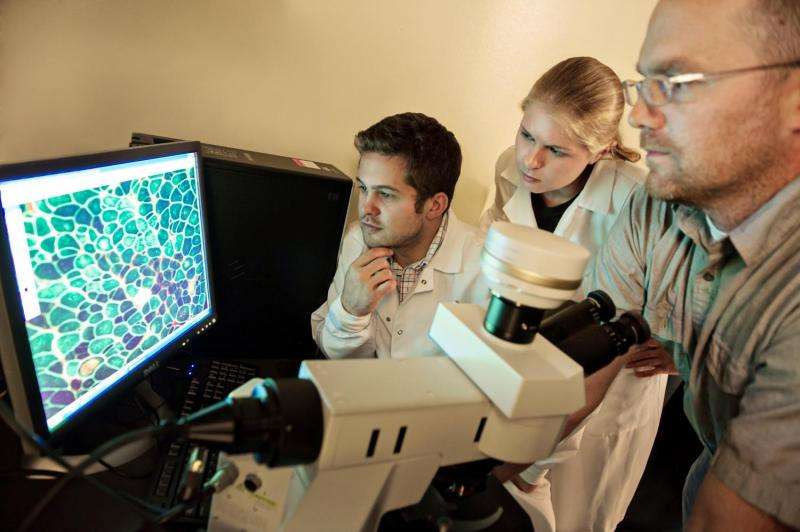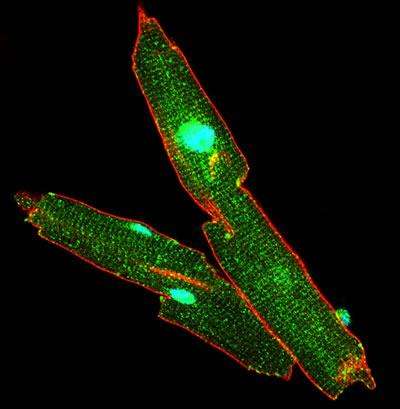Manipulating cell signaling for better muscle function in muscular dystrophy

Every heart beat and step in our daily lives is dependent on the integrity of muscles and the proteins that keep them strong and free of injury as they contract and relax.
Researchers at the University of Michigan Health System have identified a new way of triggering the instructions normally given by the muscle protein dystrophin, which is found in the muscles used for movement and in cardiac muscle cells.
Their study published online ahead of print in PNAS Early Edition suggests a new therapeutic strategy for patients with Duchene muscular dystrophy, a progressive neuromuscular condition, caused by a lack of dystrophin, that usually leaves patients unable to walk on their own by age 10-15.
When dystrophin is missing from the muscle cell, the function of another protein, known as nNOS, is impaired, resulting in decreased blood flow to the muscles and exaggerated fatigue after exercise.
Using isolated heart cells from dystrophin-deficient mice, the team of Daniel E. Michele, Ph.D., and Joanne Garbincius, of the University of Michigan Department of Molecular & Integrative Physiology, found an explanation for this debilitating protein malfunction - and a potential way to bypass it.
"Our work suggests that AMPK signaling may be one of the links between the loss of dystrophin and the impaired nNOS function that is seen in muscular dystrophy," says Michele, senior study author and professor of molecular & integrative physiology and internal medicine at the University of Michigan. "AMPK normally helps to turn on nNOS function in muscle cells, for instance when we exercise, and when dystrophin is lost, AMPK does not turn on appropriately."

AMPK, or AMP-activated protein kinase, coordinates cellular energy use. For the study, the team activated AMPK signaling with drugs that have been used medically to protect heart tissue during surgery and in sports to enhance performance because of its blood flow boosting abilities.
Once AMPK was activated, the nNOS activity that is reduced in muscular dystrophy was restored. The drug worked by bypassing the defective steps in the protein complex pathway, explains Garbincius, the lead study author.
More research is needed to determine if the process could be effective in humans.
Still the study is "an important first step to show that manipulating AMPK-nNOS signaling at least has the potential to help muscle function in muscular dystrophy," says Michele whose lab at the University of Michigan Cardiovascular Research Center focuses on inherited forms of skeletal and cardiac diseases.
Their work was supported by funding from the Muscular Dystrophy Association and the National Institutes of Health, along with funding from the U-M Cardiovascular Translational Research and Entrepreneurship training program.
Training grants from the NIH and the Cardiovascular Center supported the work of Ph.D. candidate Garbincius who helped design the study and performed the research.
Manipulating proteins in the body to compensate for the lack of dystrophin is one of many strategies being investigated to halt or reverse the muscle damage caused by DMD.
In addition to weakness of the skeletal muscles, cardiac muscle cells can weaken and die, preventing the heart from pumping blood efficiently. Dilated cardiomyopathy is a leading cause of death for those with DMD.
Other researchers have started investigating the possibility that phosphodiesterase inhibitors, which dilate blood vessels, can improve muscle function in people with DMD.
Phosphodiesterase inhibitors are in a class of drugs that include sildenafil (Viagra) and tadalafil (Cialis), both used to treat erectile dysfunction. Experiments have shown treatment with sildenafil significantly improved heart function in mice missing the dystrophin protein.
Drugs tested by the U-M appear to correct the signaling pathway that is disrupted in muscular dystrophy at an earlier step than the phosphodiesterase inhibitors.
More information: Joanne F. Garbincius et al. Dystrophin–glycoprotein complex regulates muscle nitric oxide production through mechanoregulation of AMPK signaling, Proceedings of the National Academy of Sciences (2015). DOI: 10.1073/pnas.1512991112














